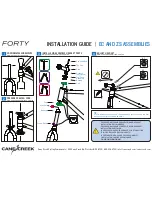
PDF: 4749051511/Source: 7788125767
Aptina reserves the right to change products or specifications without notice.
MT9T111_DG - Rev. B 9/10 EN
103
©2007 Aptina Imaging Corporation. All rights reserved.
MT9T111: Developer Guide
Auto Exposure (AE)
Preliminary
Auto Exposure (AE)
Introduction
The AE algorithm performs automatic adjustments of the image brightness by control-
ling exposure time and analog gains of the sensor core, as well as digital gains applied to
the image.
AE is implemented by a firmware driver that analyzes image statistics collected by the
exposure measurement engine. It makes a decision and programs the sensor core and
color pipeline to achieve the desired exposure. The measurement engine subdivides the
image into 16 windows organized as a 4 x 4 grid.
Two AE algorithm modes are available:
• Average brightness tracking (ABT)
• Dynamic range tracking (DRT)
The average brightness tracking AE uses a constant average tracking algorithm where a
target brightness value is compared to a current brightness value, and the gain and inte-
gration time are adjusted accordingly to meet the target requirement.
The dynamic range tracking AE examines the data from the statistics engine and
produces a corrected brightness target so that overexposed or underexposed scenes can
be avoided. This also allows a manual control of the image brightness. Both algorithms
are used in both preview and capture modes.
AE Driver
The AE driver is activated during preview and video capture mode. It relies on the statis-
tics engine that tracks speed and amplitude of the change of the overall luminance in the
selected windows of the image.
Backlight compensation is achieved by weighting the luminance in the center of the
image higher than the luminance on the periphery. Other algorithm features include the
rejection of fast fluctuations in illumination (time-averaging), control of speed of
response, and control of the sensitivity to the small changes. While the default settings
are adequate in most situations, the user can program target brightness, measurement
window, and other parameters described above.
The driver calculates image brightness based on average luma values received from
16 programmable, equal-size rectangular windows forming a 4 x 4 grid. In preview
mode, sixteen windows are combined in two segments: central and peripheral. The
central segment includes four central windows. All remaining windows belong to the
peripheral segment. Scene brightness is calculated as average luma in each segment
taken with certain weights.
The driver changes AE parameters (integration time, gains, and so on) to drive bright-
ness to the programmable target. The value of the single step approach to the target
value can be controlled.
To avoid unwanted reaction of AE on small fluctuations of scene brightness or momen-
tary scene changes, the AE driver uses a temporal filter for luma and a threshold around
the AE luma target. The driver changes AE parameters only if the buffered luma is larger
than the AE target step and pushes the luma beyond the threshold.
















































